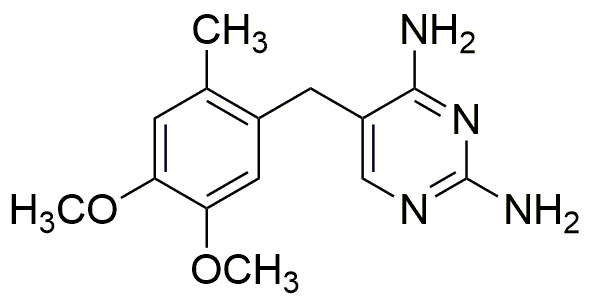Ormetoprim is widely utilized in research focused on:
- Veterinary Medicine: It is primarily used as an antimicrobial agent in livestock, particularly in poultry and swine, to prevent and treat bacterial infections, enhancing animal health and productivity.
- Pharmaceutical Development: Researchers explore its potential in developing new medications, leveraging its unique properties to create effective treatments for various infections.
- Feed Additives: In the agricultural sector, it is incorporated into animal feed to improve growth rates and feed efficiency, providing a cost-effective solution for farmers.
- Research Studies: It serves as a model compound in pharmacological studies, helping scientists understand drug interactions and resistance mechanisms in bacteria.
- Environmental Impact Assessments: Its use in veterinary applications prompts studies on its environmental effects, aiding in the development of sustainable practices in animal husbandry.
Informations générales
Propriétés
Sécurité et réglementation
Applications
Ormetoprim is widely utilized in research focused on:
- Veterinary Medicine: It is primarily used as an antimicrobial agent in livestock, particularly in poultry and swine, to prevent and treat bacterial infections, enhancing animal health and productivity.
- Pharmaceutical Development: Researchers explore its potential in developing new medications, leveraging its unique properties to create effective treatments for various infections.
- Feed Additives: In the agricultural sector, it is incorporated into animal feed to improve growth rates and feed efficiency, providing a cost-effective solution for farmers.
- Research Studies: It serves as a model compound in pharmacological studies, helping scientists understand drug interactions and resistance mechanisms in bacteria.
- Environmental Impact Assessments: Its use in veterinary applications prompts studies on its environmental effects, aiding in the development of sustainable practices in animal husbandry.
Documents
Fiches de données de sécurité (FDS)
La FDS fournit des informations de sécurité complètes sur la manipulation, le stockage et l’élimination du produit.
Spécifications du produit (PS)
Le PS fournit une description complète des propriétés du produit, notamment sa composition chimique, son état physique, sa pureté et les exigences de stockage. Il détaille également les plages de qualité acceptables et les applications prévues du produit.
Certificats d'analyse (COA)
Recherchez des certificats d'analyse (COA) en saisissant le numéro de lot du produit. Les numéros de lot et de lot se trouvent sur l'étiquette d'un produit, après les mots « Lot » ou « Lot de fabrication ».
Numéro de catalogue
Numéro de lot/série
Certificats d'origine (COO)
Ce certificat d'exploitation confirme le pays dans lequel le produit a été fabriqué, et détaille également les matériaux et composants utilisés et s'il est issu de sources naturelles, synthétiques ou autres sources spécifiques. Ce certificat peut être requis pour les douanes, le commerce et la conformité réglementaire.
Numéro de catalogue
Numéro de lot/série
Fiches de données de sécurité (FDS)
La FDS fournit des informations de sécurité complètes sur la manipulation, le stockage et l’élimination du produit.
DownloadSpécifications du produit (PS)
Le PS fournit une description complète des propriétés du produit, notamment sa composition chimique, son état physique, sa pureté et les exigences de stockage. Il détaille également les plages de qualité acceptables et les applications prévues du produit.
DownloadCertificats d'analyse (COA)
Recherchez des certificats d'analyse (COA) en saisissant le numéro de lot du produit. Les numéros de lot et de lot se trouvent sur l'étiquette d'un produit, après les mots « Lot » ou « Lot de fabrication ».
Numéro de catalogue
Numéro de lot/série
Certificats d'origine (COO)
Ce certificat d'exploitation confirme le pays dans lequel le produit a été fabriqué, et détaille également les matériaux et composants utilisés et s'il est issu de sources naturelles, synthétiques ou autres sources spécifiques. Ce certificat peut être requis pour les douanes, le commerce et la conformité réglementaire.


